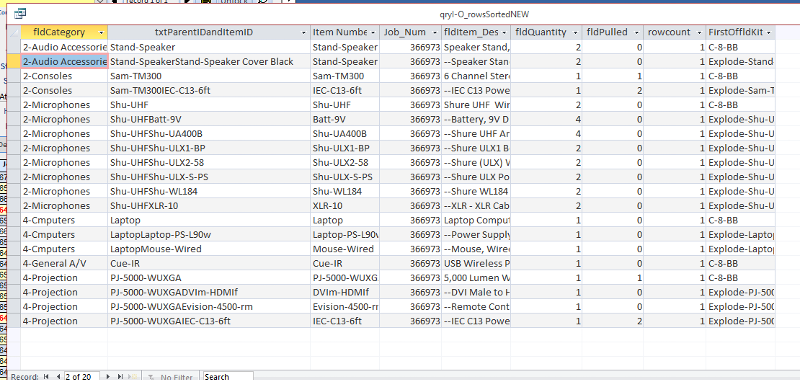Aggregate value is used twice in query barcode scanning app
Hello,
I have a barcode scanning app that has a problem with some aggregates being "used" twice.
There are some nested queries that look like this:
Query to sum up the quantities of barcodes pulled/scanned-
Then a query with the items on the job with the scan results-
See the results of these two below.

So, the question becomes, how can I structure this query to display the correct "items pulled/scanned"?
The posted queries are access sql, but the backend is ms sql, so fixes in either syntax could work.
Thank you
I have a barcode scanning app that has a problem with some aggregates being "used" twice.
There are some nested queries that look like this:
Query to sum up the quantities of barcodes pulled/scanned-
SELECT tblFixedAssets.Staff_ID
,Count(tblFixedAssets.Staff_ID) AS CountOfStaff_ID
FROM tblPulls
INNER JOIN tblFixedAssets ON tblPulls.ItemBarCode = tblFixedAssets.fldBarCode
WHERE (
((tblPulls.Job_Num) = [forms] ! [frmI-O] ! [JobToPull])
AND ((tblPulls.PulledStatus) = 'O')
)
GROUP BY tblFixedAssets.Staff_ID;Then a query with the items on the job with the scan results-
SELECT tblJobsLineItems.Job_Num
,tblJobsLineItems.[Item Number]
,First(tblJobsLineItems.Category) AS fldCategory
,First(tblJobsLineItems.Item_Description) AS fldItem_Description
,Sum(tblJobsLineItems.Quantity) AS fldQuantity
,Count(tblJobsLineItems.[Item Number]) AS ROWCOUNT
,First(tblJobsLineItems.fldKit) AS FirstOffldKit
,Sum(Nz([CountOfStaff_ID])) AS fldPulled
,tblJobsLineItems.ParentID
FROM tblJobsLineItems
LEFT JOIN [qryI-O-PulledByJob] ON tblJobsLineItems.[Item Number] = [qryI-O-PulledByJob].Staff_ID
WHERE (((tblJobsLineItems.Job_Num) = [forms] ! [frmI-O] ! [JobToPull]))
GROUP BY tblJobsLineItems.Job_Num
,tblJobsLineItems.[Item Number]
,tblJobsLineItems.ParentID
ORDER BY tblJobsLineItems.[Item Number]
,First(tblJobsLineItems.Category);See the results of these two below.

So, the question becomes, how can I structure this query to display the correct "items pulled/scanned"?
The posted queries are access sql, but the backend is ms sql, so fixes in either syntax could work.
Thank you
ASKER
one more note. There is one more level of query on top to get this back in the right category and have the correct parent id.
SELECT [qryI-O_rowsNEW].fldCategory
,[qryI-O_rowsNEW].[Item Number]
,[qryI-O_rowsNEW].Job_Num
,[qryI-O_rowsNEW].fldItem_Description
,[qryI-O_rowsNEW].fldQuantity
,[qryI-O_rowsNEW].fldPulled
,[qryI-O_rowsNEW].ROWCOUNT
,[qryI-O_rowsNEW].FirstOffldKit
FROM [qryI-O_rowsNEW]
WHERE ((([qryI-O_rowsNEW].fldCategory) <> "9-Discount"))
ORDER BY [qryI-O_rowsNEW].fldCategory
,[parentid] & [item number];
Do you want to change the above query ? any issue with above ?
ASKER
Hello Pawan,
The "Sum(DISTINCT Nz([CountOfStaff_ID])) AS fldPulled' causes a syntax error that I have not been able to work around.
The "Sum(DISTINCT Nz([CountOfStaff_ID])) AS fldPulled' causes a syntax error that I have not been able to work around.
ASKER
Hello Pawan,
I re-wrote in ms sql and nested the queries and see that DISTINCT solves the problem of the re-use of that value. But, my sorting and grouping is not working now.
I re-wrote in ms sql and nested the queries and see that DISTINCT solves the problem of the re-use of that value. But, my sorting and grouping is not working now.
With qryPulledByJob as (
SELECT tblFixedAssets.Staff_ID
,Count(tblFixedAssets.Staff_ID) AS CountOfStaff_ID
FROM tblPulls
INNER JOIN tblFixedAssets ON tblPulls.ItemBarCode = tblFixedAssets.fldBarCode
WHERE (
((tblPulls.Job_Num) = 366973)
AND ((tblPulls.PulledStatus) = 'O')
)
GROUP BY tblFixedAssets.Staff_ID
)
SELECT tblJobsLineItems.[Item Number]
,Sum(tblJobsLineItems.Quantity) fldQuantity
,Count(tblJobsLineItems.[Item Number]) totQty
,Sum(DISTINCT [CountOfStaff_ID]) AS fldPulled
FROM tblJobsLineItems
LEFT JOIN [qryPulledByJob] ON tblJobsLineItems.[Item Number] = [qryPulledByJob].Staff_ID
WHERE (((tblJobsLineItems.Job_Num) = 366973))
GROUP BY tblJobsLineItems.[Item Number]ASKER
So, in attempting to get the categories back together, adding another group by spoils the count.
Here are results.
With qryPulledByJob as (
SELECT tblFixedAssets.Staff_ID
,Count(tblFixedAssets.Staff_ID) AS CountOfStaff_ID
FROM tblPulls
INNER JOIN tblFixedAssets ON tblPulls.ItemBarCode = tblFixedAssets.fldBarCode
WHERE (
((tblPulls.Job_Num) = 366973)
AND ((tblPulls.PulledStatus) = 'O')
)
GROUP BY tblFixedAssets.Staff_ID
)
SELECT tblJobsLineItems.[Item Number]
,Sum(tblJobsLineItems.Quantity) fldQuantity
,Count(tblJobsLineItems.[Item Number]) totQty
,Sum(DISTINCT [CountOfStaff_ID]) AS fldPulled
FROM tblJobsLineItems
LEFT JOIN [qryPulledByJob] ON tblJobsLineItems.[Item Number] = [qryPulledByJob].Staff_ID
WHERE (((tblJobsLineItems.Job_Num) = 366973))
GROUP BY tblJobsLineItems.[Item Number]
,tblJobsLineItems.CategoryHere are results.
Stand-Speaker 2 1 NULL
Stand-Speaker Cover Black 2 1 NULL
IEC-C13-6ft 1 1 2
Sam-TM300 1 1 1
Batt-9V 4 1 NULL
Shu-UA400B 4 1 NULL
Shu-UHF 2 1 NULL
Shu-ULX1-BP 2 1 NULL
Shu-ULX2-58 2 1 NULL
Shu-ULX-S-PS 2 1 NULL
Shu-WL184 2 1 NULL
XLR-10 2 1 NULL
Laptop 1 1 NULL
Laptop-PS-L90w 1 1 NULL
Mouse-Wired 1 1 NULL
Cue-IR 1 1 NULL
DVIm-HDMIf 1 1 NULL
Evision-4500-rm 1 1 NULL
IEC-C13-6ft 1 1 2
PJ-5000-WUXGA 1 1 1
Create a query that groups the distinct Staff_ID values. Then count that query. OR use a pass-through query that uses the SQL Server syntax which does support the count distinct.
What different result you want from the last one you commented?
ASKER
You need to do like below--
SELECT * FROM
(
SELECT DISTINCT .....
FROM
.........
)y
ORDER BY....
SELECT * FROM
(
SELECT DISTINCT .....
FROM
.........
)y
ORDER BY....
ASKER
I have tried many variations, but I either get the correct counts or the desired formatting.
SELECT DISTINCT
tbljobslineitems.category
,tblJobsLineItems.parentid
,tblJobsLineItems.[Item Number]
,Quantity
,qryPulledByJob.SumPull
,concat(ParentID, [Item Number]) Sorting
FROM tblJobsLineItems
LEFT JOIN (
SELECT tblFixedAssets.Staff_ID
,Count(tblFixedAssets.Staff_ID) AS SumPull
,Max(Job_Num) AS Job_Num
FROM tblPulls
INNER JOIN tblFixedAssets ON tblPulls.ItemBarCode = tblFixedAssets.fldBarCode
WHERE (
((tblPulls.Job_Num) = 366973)
AND ((tblPulls.PulledStatus) = 'O')
)
GROUP BY tblFixedAssets.Staff_ID
) AS qryPulledByJob ON tblJobsLineItems.[Item Number] = qryPulledByJob.Staff_ID
WHERE tblJobsLineItems.Job_Num=366973
ORDER BY Category, concat(ParentID,[Item Number])This question needs an answer!
Become an EE member today
7 DAY FREE TRIALMembers can start a 7-Day Free trial then enjoy unlimited access to the platform.
View membership options
or
Learn why we charge membership fees
We get it - no one likes a content blocker. Take one extra minute and find out why we block content.

Open in new window
Open in new window